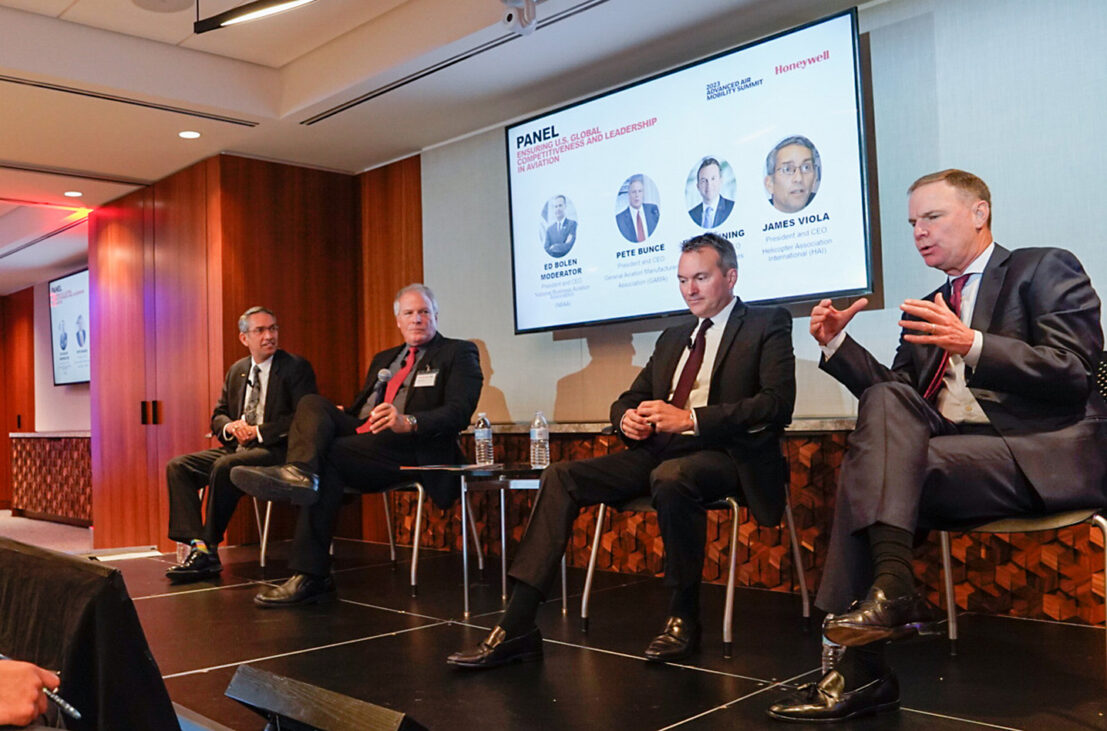
July 18, 2023
To ensure the U.S. maintains its position as a global aerospace leader as advanced air mobility (AAM) becomes a reality, government and industry will need to work together and bypass bureaucracy to keep our competitive advantage.
That was the overarching message from a panel discussion titled, “Ensuring United States Global Competitiveness in Aviation,” which took place in Washington, DC on July 18 during Honeywell’s second annual Advanced Air Mobility Summit.
Moderated by NBAA President and CEO Ed Bolen, panelists included: Pete Bunce, president and CEO of the General Aviation Manufacturers Association; Eric Fanning, president and CEO of the Aerospace Industry Association and James Viola, president and CEO of the Helicopter Association International.
“The benefits of AAM create a national imperative to get it done,” said Bolen. “We have an opportunity to have American leadership in an industry that’s going to have a profound impact for the future.”
Archer Aviation CEO Adam Goldstein, who opened the summit, noted that Morgan Stanley predicts AAM will be a $6 billion market by 2035 and a $1 trillion market by 2040. “These vehicles are really designed for everyone, not just a select group,” he said.
Fanning noted that from a technology point of view, the U.S. is “in a good place,” adding “What I worry about is our government side in this because other countries really want in on this in terms of the economic development.
“I would say when we have put everything in place we need to, it’s hard for anyone to compete with the United States, the innovation that comes out of the United States,” he said, “But I do worry about where we are politically and governmentally right now.”
Bunce called the AAM era “as exciting as the dawn of the jet age.”
“We have the capability right now to be able to do something that no nation on the planet can do,” he said, though there’s concern that the government cause holdups. “We are going to integrate, and we have the capability to do that. We know how to do this.”
The FAA, Bunce said, has made commitments to get these aircraft in the air in 2025. “But beyond that, we need the federal government to think long term about how this new mode of transportation is going to move people from rural cities to the hubs, how we’re going to be able to get the airspace around metropolitan areas to be able to function when we take these out of the crawl, walk, run phase.”
There is strong support in Congress for the technology, Bunce added. For example, last year they passed, and the president signed into law, the Advanced Air Mobility Coordination and Leadership Act, which will promote policies, procedures and programs to support the integration of this emerging aviation sector into America’s transportation infrastructure. Also, the FAA reauthorization bill is expected to contain provisions in support of AAM.
“We’re close enough now that people feel the excitement,” said Viola, adding, “We have to apply the right rules to the right aircraft.” The FAA, he said, needs to listen to industry. If they don’t it will be problematic and will put the U.S. behind other countries.
Future Workforce
Bolen said AM should “help the industry inspire and attract the best and the brightest,” to be a part of this new technology and mode of transportation.
Fanning said having a skilled workforce is a concern and a “whole-country approach” is needed to make sure young people are aware of AAM and its benefits. Also, he said, it can’t be only an industry undertaking, government needs to step in as well.
Bunce noted the FAA also needs to have engineers and others in its ranks who understand this technology and have expertise in this field. Viola suggested FAA employees should work with industry companies and be present during the development of the technology, before going on to help with its oversight.
While panelists noted safety and sustainability are critical for AAM to succeed and thrive, Fanning added having the right talent in place also is critical to success.
“I would just ask everybody who is here to recognize how special this opportunity is, to make sure that we are working to articulate that and make sure that we are understanding that this is our future,” Bolen concluded. “We have been blessed in aviation to have been able to stand on the shoulders of lots of giants who have provided technology and innovation and have changed our lives and have changed the world.
“Let’s recognize that going forward, this is our opportunity to make a profound difference and ensure U.S. global leadership.”


 International Business Aviation Council Ltd.
International Business Aviation Council Ltd.